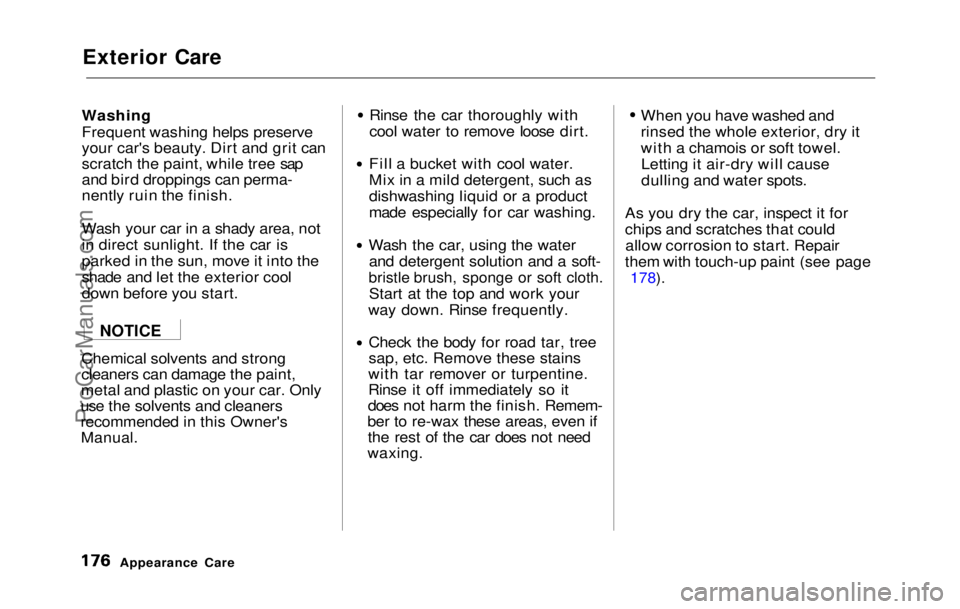1992 HONDA PRELUDE ESP
[x] Cancel search: ESPPage 119 of 225

Driving in Bad Weather
Driving Technique — Always
drive slower than you would in dry
weather. It takes your car longer to react, even in conditions that may
seem just barely damp. Apply
smooth, even pressure to all the
controls. Abrupt steering wheel
movements or sudden, hard appli-
cation of the brakes can cause loss
of control in wet weather. Be extra
cautious for the first few miles of
driving while you adjust to the change in driving conditions. This
is especially true in snow. A person
can forget some snow-driving tech- niques during the summer months.
Practice is needed to relearn those
skills.
Exercise extra caution when
driving in rain after a long dry spell.
After months of dry weather, the
first rains bring oil to the surface of
the roadway, making it slippery. Visibility — Being able to see
clearly in all directions and being
visible to other drivers are impor-
tant in all weather conditions. This is more difficult in bad weather. To
be seen more clearly during day-
light hours, turn on your headlights.
Inspect your windshield wipers and
washers frequently. Keep the wind- shield washer reservoir full of the
proper fluid. Replace the wind-
shield wiper blades if they start to
streak the windshield or leave parts
unwiped. Use the defrosters and air conditioner to keep the windows
from fogging up on the inside (see
page 73).
Traction — Check your tires
frequently for wear and proper pressure. Both are important in
preventing "hydroplaning" (loss of
traction on a wet surface). In the
winter, mount snow tires on all four
wheels for the best handling.
Watch road conditions carefully, they can change from moment to
moment. Wet leaves can be as slip-
pery as ice. "Clear" roads can have
patches of ice. Driving conditions
can be very hazardous when the
outside temperature is near freez-
ing. The road surface can become
covered with areas of water pud-
dles mixed with areas of ice, so
your traction can change without
warning.
Be careful when downshifting. If
traction is low, you can lock up the
drive wheels for a moment and
cause a skid.
DrivingProCarManuals.comMain Menu Table of Contents s t
Page 124 of 225

Towing a Trailer
Driving
When parking your car and trailer,
especially on a hill, be sure to
follow all the normal precautions.
Turn your front wheels into the curb, set the parking brake firmly,
and put the transmission in 1st or
Reverse (5-speed) or Park (auto-
matic). In addition, place wheel chocks at each of the trailer's tires.
Backing up with a trailer is diffi-
cult and takes practice. Drive
slowly, make small movements
with the steering wheel, and havesomeone stand outside to guide you.
Grip th e
steering wheel on the
bottom (rather than the usual posi- tion near the top). Move your hand
to the left to get the trailer to move
to the left, and right to move the
trailer right.ProCarManuals.comMain Menu Table of Contents s t
Page 160 of 225

Tires
Traction
The traction grades, from highest
to lowest, are A, B, and C, and they
represent the tire's ability to stop
on wet pavement as measured
under controlled conditions on
specified government test surfaces
of asphalt and concrete. A tire
marked C may have poor traction
performance.
Warning: The traction grade as-
signed to this tire is based on brak-
ing (straight ahead) traction tests
and does not include cornering
(turning) traction.
Temperature
The temperature grades are A (the
highest), B, and C, representing the
tire's resistance to the generation
of heat and its ability to dissipate
heat when tested under controlled
conditions on a specified indoor
laboratory test wheel. Sustained
high temperature can cause the
material of the tire to degenerate
and reduce tire life, and excessive
temperature can lead to sudden tire
failure. The grade C corresponds to a level of performance which all
passenger car tires must meet
under the Federal Motor Vehicle
Safety Standard No. 109. Grades B
and A represent higher levels of
performance on the laboratory test
wheel than the minimum required
by law. Warning: The temperature grade
for this tire is established for a tire
that is properly inflated and not
overloaded. Excessive speed,
underinflation, or excessive loading.
either separately or in combination,
can cause heat build-up and
possible tire failure.
MaintenanceProCarManuals.comMain Menu Table of Contents s t
Page 173 of 225

Exterior Care
Washing
Frequent washing helps preserve
your car's beauty. Dirt and grit can
scratch the paint, while tree sap
and bird droppings can perma-
nently ruin the finish.
Wash your car in a shady area, not
in direct sunlight. If the car is
parked in the sun, move it into the
shade and let the exterior cool
down before you start.
Chemical solvents and strong
cleaners can damage the paint,
metal and plastic on your car. Only
use the solvents and cleaners
recommended in this Owner's
Manual.
Rinse the car thoroughly with
cool water to remove loose dirt.
Fill a bucket with cool water.
Mix in a mild detergent, such as
dishwashing liquid or a product
made especially for car washing.
Wash the car, using the water and detergent solution and a soft-bristle brush, sponge or soft cloth.
Start at
the top and work your
way down. Rinse frequently.
Check the body for road tar, tree
sap, etc. Remove these stains
with tar remover or turpentine.
Rinse it off immediately so it
does not harm the finish. Remem-
ber to re-wax these areas, even if the rest of the car does not need
waxing. When you have washed and
rinsed the whole exterior, dry it
with a chamois or soft towel.
Letting it air-dry will cause
dulling and water spots.
As you dry the car, inspect it for
chips and scratches that could allow corrosion to start. Repair
them with touch-up paint (see page
178).
Appearance Care
NOTICEProCarManuals.comMain Menu Table of Contents s t
Page 178 of 225

Corrosion Protection, Body Repairs
Inspect and clean out the drain
holes in the bottom of the doors
and body.
Check the floor coverings for
dampness. Carpeting and floor mats may remain damp for a long
time, especially in winter. This dampness can eventually cause
the floor panels to corrode.
Use a high-pressure spray to
clean the underside of your car.
This is especially important in
areas that use road salt in winter. It is also a good idea in humid
climates and areas subject to salt
air. Cars equipped with ABS
have a sensor and wiring at each
wheel. Be careful not to damage
them.
Have the corrosion-preventive
coatings on the underside of your
car inspected and repaired
periodically.
Body Repairs
Body repairs affect your car's
resistance to corrosion. If your car
needs repairs after a collision, pay
close attention to the parts used in
the repair and the quality of the
work.
Make sure the repair facility uses
genuine Honda replacement body
parts. Some companies make
sheetmetal pieces that seem to
duplicate the original Honda body parts, but are actually inferior in fit,
finish, and quality. Once installed,
they do not give the same high- quality appearance and level of
corrosion resistance. When reporting your collision to
the insurance company, tell them
you want genuine Honda parts
used in the repair. Although most insurers recognize the higherquality of original parts, some may
try to specify that the repairs be
done with the "lowest cost" parts
available. You should investigate
this before any repairs are begun.
Take your car to your authorized Honda dealer for inspection after
the repairs are completed. He can make sure that quality materials
were used, and that corrosion-
preventive coatings were applied to
all repaired and replaced parts.
Appearance Car e
ProCarManuals.comMain Menu Table of Contents s t
Page 180 of 225

Compact Spare Tire
Your car has a compact spare tire
that takes up less space. Use this
spare tire as a temporary replace-
ment only. Get your regular tire
repaired or replaced and put back
on your car as soon as you can.
Check the inflation of the compact
spare tire every time you check the
other tires. It should be inflated to: 415 kPa (4.15 kg/cm2, 60 psi)
Follow these precautions whenever
you are using the compact spare
tire:
Do not exceed 50 mph (80 km/h)
under any circumstances. This tire gives a harsher ride and
less traction on some road sur-
faces than the regular tire. Use
greater caution while driving on
this tire.
Do not mount snow chains on the
compact spare.
The wheel
of the compact spare
tire is designed especially to fit
your car. Do not use your spare
tire on another car unless it is the
same make and model. The compact spare tire has a
shorter tread life than a regular
tire. Replace it when you can see
the tread wear indicator bars. The
replacement should be the same
size and design tire, mounted on
the same wheel. The compact spare
tire is not designed to be mounted
on a regular wheel, and the com- pact wheel is not designed for
mounting a regular tire.
Taking Care of the Unexpected
INDICATOR
LOCATION
MARK
TREAD WEARINDICATOR
BARProCarManuals.comMain Menu Table of Contents s t
Page 206 of 225

Four Wheel Steering
The Si 4WS model in the U. S and
the SR 4WS model in Canada are
equipped with an electronic Four
Wheel Steering system.
As inputs, the 4WS system uses a
vehicle speed sensor and a sensor to measure how far the front
wheels are turned.
The electronic control unit for 4WS system uses these inputs to deter-
mine which direction to steer the
rear wheels, and at what angle. Depending on vehicle speed and the
angle of the front wheels, the rear
wheels will be "countersteered"
(steered in the opposite direction of
the front wheels) or "same-steered"
(steered in the same direction as
the front wheels). The 4WS electronic control unit
drives an electric motor built into
the rear steering box. Sensors for
rear wheel angle and speed provide
feedback. The electronic control
unit uses this feedback to compare
the actual rear wheel angle to the
desired angle.
When the driver turns the front
wheels with the car traveling less
than 18 mph (30 km/h), the rear
wheels are countersteered. The angle of countersteer increases as
the angle of the front wheels in-
creases, to a maximum counter-
steer angle of six degrees. This
improves response when parallel
parking or making sharp turns.
Above 18 mph (30 km/h), the rear
wheels are same-steered as the driver begins to turn the steering
wheel. The rear wheel angle for
any given steering wheel angle is
not fixed; it increases as vehicle speed increases. This improves
response in lane-changing maneu-
vers.
As the driver continues to turn the
steering wheel, the rear wheels are
steered back to the straight-ahead
position and then to countersteer
mode. As with same steer, the
angle of countersteer varies with
vehicle speed; increasing and then decreasing as the speed rises. This
gives improved handling in low, medium, and high speed curves.
The 4WS system's electronic
control unit monitors the sensors
whenever the ignition is ON. If it detects a problem anywhere in the
system, it lights the 4WS indicator
on the instrument panel and turns
the system off. With the system off,
the rear wheels remain pointed
straight ahead. Your car will then
drive like a conventional car
without 4WS.
Technical InformationProCarManuals.comMain Menu Table of Contents s t